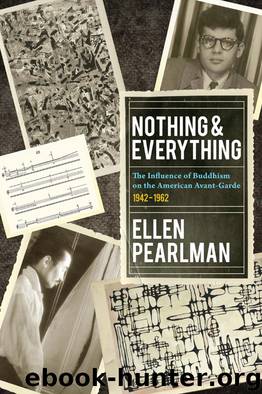Nothing and Everything by Ellen Pearlman

Author:Ellen Pearlman [Pearlman, Ellen]
Language: eng
Format: epub
ISBN: 978-1-58394-379-3
Publisher: North Atlantic Books
Published: 2012-04-23T16:00:00+00:00
Lassaw’s Investigations and Buddhist Phenomenology
Ibram Lassaw’s personal journal entries were filled with insights from the psychedelics he was ingesting, something very few were involved with at the time. They chronicle his understanding of the dissolving of borders between subject and object placed squarely in the context of classical Zen “nowness,” emphasizing no receiver and nothing to be received, as well as no hierarchy and no non-hierarchy. He felt he was an embodiment of action encased in form acting according to his own nature and karma. This does not imply he was enlightened; nor did it mean psychedelics were his sole means of inquiry. He knew that his role as an artist was to reveal this universal connection to others. Each sculpture was a representative, just like a calligraphic brushstroke, as the thing as it is. The thing as it is also paralleled the literary technique of “first thought, best thought,” meaning the moment before conceptuality arises. When welding a sculpture with a oxy-acetylene torch, Lassaw focused exactly on what was in front of him so “no conscious ideas intrude themselves into the work.”28 He developed sculptural space as “greater and lesser densities of concentration.”29 He explored the lattices in Indra’s net with a sculpture called Akasa;30 made Mandala, a piece about “interiority” made out of polychrome plastic; and called another long, wiry piece Mantra. He sculpted Tathata, with freestanding forms locking and holding each other in a precariously balanced moment of time, and even wrote in his daybooks the “Sutra of Ibram Lassaw, the aesthetic appreciation of thusness.”31 In 1956, when he exhibited in Alfred Barr’s Twelve Americans show at the Museum of Modern Art, his statement in the catalog described how conceptual mind made him “blind” and in a “fog” as to the reality that was omnipresent all the time.
What did Lassaw mean that conceptual mind blinded him to the “now”? According to Buddhist phenomenology and psychology, there are five skandhas (heaps), or five stages of ego that stack on top of one another in about a sixtieth of a second in reaction to an experience. The first skandha occurs when the mind is absolutely open and spacious. Perception is fresh and direct, and there is no rigid self. This is tathagata, or “suchness.” The second skandha quickly arises, trying to fill the space or void. This is the moment a person “feels” and solidifies the discrimination of “this and that,” shutting down tathagata.
The third skandha, “perceptions and impulse,” is when the ego strategizes on how to fill space through the filter of passion, aggression, or indifference. Indifference works like armor, numbing sensitive spots. Passion consumes, and the more impoverished one feels, the more it consumes. Aggression comes from feeling you can’t survive and must ward off everything harder and faster. This happens rapidly, and intellect, cognition, and language aid the decision about what to accept and what to reject. The fourth skandha, “concept,” categorizes the impulse or perception colored by an individual’s environment, culture, and upbringing.
The division of all this mental labor needs a container, which is the fifth skandha, “consciousness.
Download
This site does not store any files on its server. We only index and link to content provided by other sites. Please contact the content providers to delete copyright contents if any and email us, we'll remove relevant links or contents immediately.
| Body Art & Tattoo | Calligraphy |
| Ceramics | Conceptual |
| Digital | Erotic |
| Film & Video | Glass |
| Graffiti & Street Art | Illuminations |
| Installations | Mixed Media |
| Mosaic | Prints |
| Public Art | Video Games |
Kathy Andrews Collection by Kathy Andrews(11730)
Thirteen Reasons Why by Jay Asher(8796)
The Red Files by Lee Winter(3368)
How to Do Nothing by Jenny Odell(3232)
The Genius of Japanese Carpentry by Azby Brown(3224)
Stacked Decks by The Rotenberg Collection(2812)
Tattoo Art by Doralba Picerno(2600)
Champions of Illusion by Susana Martinez-Conde & Stephen Macknik(2414)
The Artist's Way Workbook by Cameron Julia(2196)
The Art of Doom by Bethesda(2108)
Calligraphy For Dummies by Jim Bennett(1992)
Creative Character Design by Bryan Tillman(1888)
Botanical Line Drawing by Peggy Dean(1812)
Wall and Piece by Banksy(1781)
The Art of Creative Watercolor by Danielle Donaldson(1777)
One Drawing A Day by Veronica Lawlor(1767)
Art Of Atari by Tim Lapetino(1750)
Pillars of Eternity Guidebook by Obsidian Entertainment(1625)
Happy Hand Lettering by Jen Wagner(1558)
